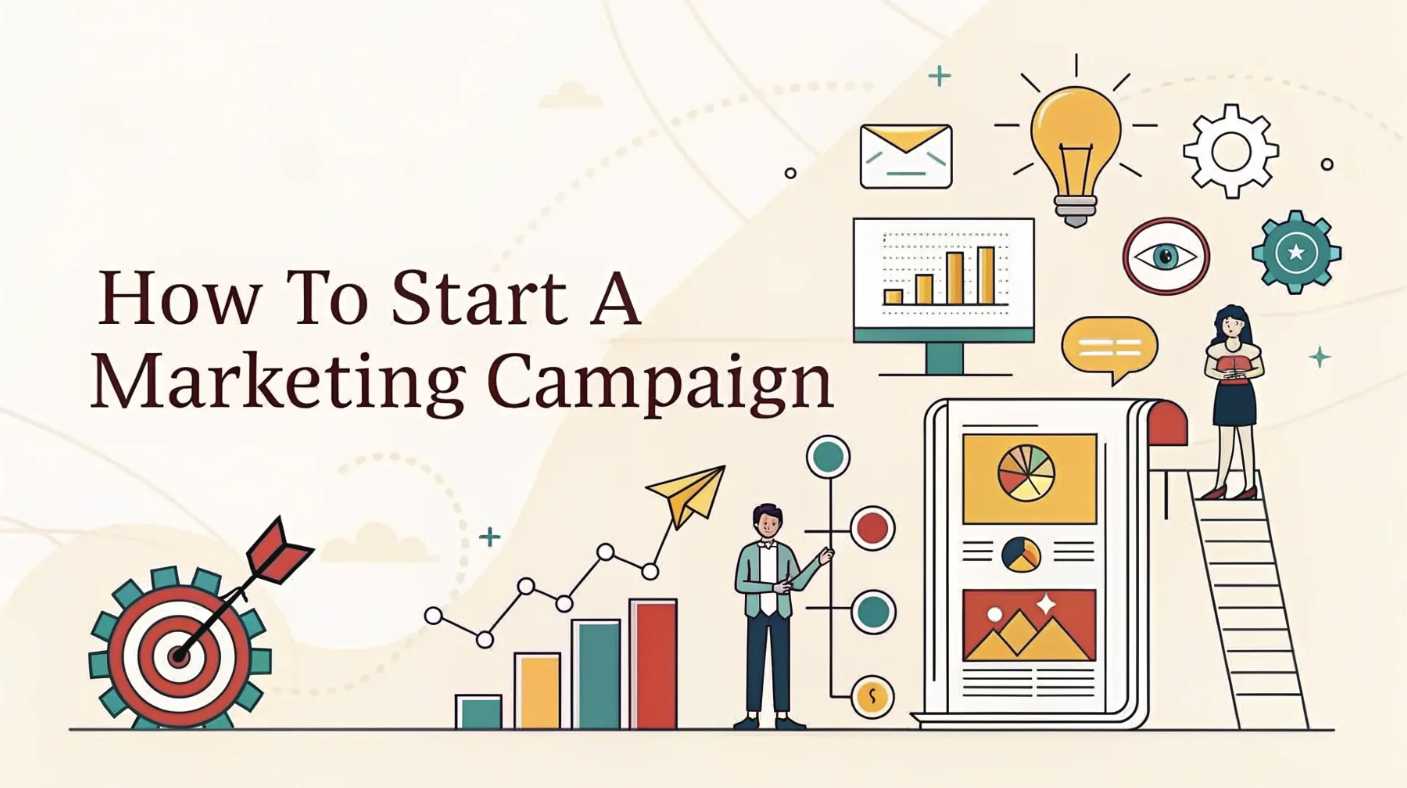
A marketing campaign can transform your business if done correctly. It’s not just about selling products; it’s about connecting with your audience and building trust. Think about Dollar Shave Club’s viral video that captured nearly half the online shaver market or Airbnb’s content strategies that helped it reach a $73 billion valuation. These campaigns didn’t happen by chance—they followed proven strategies.
You’re in the right place if you’ve ever wondered how to start a marketing campaign that drives real results. Let’s turn your ideas into a successful marketing campaign that grows your brand.
Understanding How to Start a Marketing Campaign
What Is a Marketing Campaign
A marketing campaign is a focused effort to promote a product, service, or brand using strategies and channels. It’s not just about running ads or posting on social media. Instead, it’s a well-planned initiative designed to achieve specific goals, like increasing brand awareness, generating leads, or driving sales. Think of it as a roadmap that guides your efforts to connect with your audience and deliver value.
To get started, you need to understand the key components of a campaign. These include setting clear objectives, identifying your target audience, choosing the right channels, crafting a compelling message, allocating your budget, and creating a timeline.
When all these elements come together, your campaign becomes a powerful tool to grow your business.
Types of Marketing Campaigns
Marketing campaigns come in various forms, each tailored to different goals and audiences. Let’s explore the most common types:
Digital Campaigns
Digital marketing campaigns dominate today’s landscape. They include strategies like social media marketing, email marketing, SEO, and paid advertising. These campaigns are cost-effective and allow you to reach a global audience. For example, a social media campaign can help you engage directly with customers, while an SEO campaign improves your website’s visibility on search engines.
Traditional Campaigns
Traditional campaigns rely on offline methods like TV commercials, print ads, and direct mail. While they may seem outdated, they’re still effective for reaching local audiences or older demographics. A well-placed billboard or a creative direct mail piece can leave a lasting impression.
Hybrid Campaigns
Hybrid campaigns combine digital and traditional strategies to maximize impact. For instance, you might run a social media campaign alongside a radio ad to reach both online and offline audiences. This approach ensures you’re covering all bases and engaging with your audience wherever they are.
Who Should Try This
Marketing campaigns aren’t just for big corporations. They’re valuable for businesses of all sizes and stages. Here’s who can benefit:
Small Businesses
If you’re running a small business, a marketing campaign can help you attract more customers and boost brand awareness. It’s a cost-effective way to compete with larger players in your industry.
Established Brands
For established brands, campaigns are essential for staying relevant and maintaining customer loyalty. They also provide opportunities to launch new products or enter new markets.
Entrepreneurs and Startups
Startups and entrepreneurs can use campaigns to build their brand from scratch. A well-executed campaign can create buzz, attract investors, and establish a strong market presence.
Setting Goals and Identifying Your Target Audience
Defining Objectives for a Successful Marketing Campaign
Before diving into the details of your marketing campaign, you need to define your campaign objective. Clear goals keep you focused and help measure success. Here are three common objectives to consider:
Brand Awareness
Want to make your brand the talk of the town? Brand awareness campaigns are perfect for introducing your business to a wider audience. Whether you’re launching a new product or entering a new market, this type of campaign ensures people recognize your name. Use strategies like social media ads or influencer partnerships to get noticed.
Lead Generation
If your goal is to attract potential customers, focus on lead generation. This involves collecting contact information from interested individuals, like email addresses or phone numbers. Offering free resources, such as eBooks or webinars, can entice people to share their details. Once you have their information, you can nurture these leads into loyal customers.
Sales and Conversions
Looking to boost revenue? A sales-focused campaign drives purchases or sign-ups. Use limited-time offers, discounts, or compelling calls-to-action to encourage immediate action. Tracking metrics like conversion rates will help you see how well your campaign performs.
To set effective goals, follow the SMART framework:
-
Specific: Define exactly what you want to achieve.
-
Measurable: Use numbers to track progress.
-
Achievable: Be realistic about what’s possible.
-
Relevant: Align goals with your business objectives.
-
Time-bound: Set a deadline to stay on track.
Researching and Understanding Your Audience
Knowing your target audience is crucial for a successful marketing campaign. After all, how can you connect with people if you don’t understand them?
Demographics and Psychographics
Start by gathering demographic data like age, gender, income, and location. These details reveal who your audience is. Then, dive deeper with psychographics to uncover their values, interests, and lifestyles. For example, a 30-year-old fitness enthusiast might respond better to health-focused messaging than generic ads.
Customer Pain Points and Needs
What problems does your audience face? What solutions are they looking for? Identifying their pain points helps you craft messages that resonate. Use surveys, social media polls, or customer reviews to gather insights. When you address their needs directly, your campaign feels personal and impactful.
Aligning Goals with Audience Insights
Once you’ve defined your goals and studied your audience, it’s time to connect the dots. Aligning your campaign objective with audience insights ensures your efforts hit the mark. For instance, if your goal is lead generation, focus on creating content that solves your audience’s problems. Use tools like social media analytics or customer feedback to refine your strategy. When your goals and audience align, your campaign becomes more effective and engaging.
Creating a Marketing Campaign Plan
Establishing a Budget
Allocating Resources Effectively
Your marketing campaign plan starts with a solid budget. It’s not just about how much you spend but how you allocate it. Consider factors like your industry, company size, and whether you’re targeting businesses or consumers. For example:
-
Industries with high competition often require higher marketing budgets.
-
Smaller companies may spend a larger percentage of their revenue on marketing compared to larger ones.
-
B2C businesses usually allocate more to promotion strategies than B2B companies.
Align your budget with your goals. If you’re aiming for brand awareness, focus on channels like social media or influencer marketing. For lead generation, invest in tools that help capture and nurture leads. Always track which efforts deliver results to optimize spending.
Tools and Platforms to Consider
Cost-effective tools can stretch your budget further. Platforms like ConvertFlow and Aftersell offer affordable plans for creating engaging campaigns and boosting sales. Wordstream provides free insights for Google Ads, while Atria uses AI to optimize ads on Meta and TikTok. These tools simplify campaign management and help you get the most out of your resources.
Choosing the Right Channels
Social Media
Social media is a powerhouse for reaching your target audience. Platforms like Instagram, TikTok, and LinkedIn let you engage directly with users. They’re perfect for building brand awareness and driving conversions. Choose platforms where your audience spends time and tailor your content to match their preferences.
Email Marketing
Email marketing is a cost-effective way to connect with your audience. It’s highly personalized and delivers messages straight to their inbox. Use it to share promotions, nurture leads, or re-engage past customers. Just make sure your emails stand out to avoid getting lost in crowded inboxes.
Paid Advertising
Paid ads offer quick results and precise targeting. Whether it’s Google Ads or social media ads, you can reach specific demographics and track performance easily. However, keep an eye on ad fatigue and adjust your campaigns to maintain engagement.
Developing a Timeline
Setting Milestones
Break your campaign into smaller tasks and set milestones to track progress. For example, you might aim to launch your first ad within two weeks or hit a specific number of leads by the end of the month. Milestones keep you focused and ensure steady progress.
Planning for Flexibility
No campaign goes perfectly as planned. Stay flexible and ready to adapt. Monitor your campaign’s performance and adjust based on what works. Regular evaluations help you refine your approach and improve results over time.
How to Launch a Marketing Campaign
Preparing for the Launch
Testing Campaign Elements
Before you launch a marketing campaign, testing is essential. It ensures your message resonates with your target audience and aligns with your goals. Start by setting clear objectives for the test. For example, are you checking if your headline grabs attention or if your call-to-action drives clicks? Focus on key marketing campaign elements like copy, visuals, and layout. Segment your audience and test variations to see what works best for each group. This approach helps you refine your campaign and avoid costly mistakes.
Don’t forget to track results during the test phase to identify what’s effective and what needs improvement.
Coordinating Across Teams
A smooth campaign launch requires teamwork. Everyone involved—designers, copywriters, and marketers—must be on the same page. Use tools like a marketing launch calendar to organize tasks and deadlines. Schedule regular check-ins to ensure progress stays on track. Clear communication is key. Share updates, address concerns, and make sure every team member understands their role.
Executing the Launch
Monitoring Campaign Performance
Once your campaign goes live, monitoring its performance becomes your top priority. Set up analytics tools to track metrics like clicks, conversions, and engagement rates. Compare these numbers to your benchmarks to gauge success. Regular check-ins allow you to spot trends and make adjustments quickly.
Advanced analytics can also reveal deeper insights into user behavior, helping you fine-tune your strategy.
Adjusting Strategies in Real-Time
Flexibility is crucial during a campaign launch. If something isn’t working, don’t hesitate to pivot. For instance, if an ad isn’t generating clicks, tweak the headline or visuals. Use real-time data to guide your decisions. Quick adjustments can turn a struggling campaign into a successful one.
Staying adaptable ensures you make the most of your efforts.
Potential Challenges
Budget Overruns
Sticking to your budget can be tough. Unexpected costs often arise during a campaign launch. To avoid this, prioritize high-ROI activities and track expenses closely. If your budget feels tight, explore cost-effective options like social media marketing or content creation. These strategies can deliver great results without breaking the bank.
Low Engagement Rates
Low engagement can be frustrating. It often happens when your message doesn’t connect with your audience. Revisit your research to ensure you understand their needs and preferences. Adjust your messaging or visuals to make them more appealing. Testing different approaches can also help you find what resonates best.
Pro Tip: Keep your campaign consistent across all channels. A cohesive message strengthens your brand and boosts engagement.
Evaluating and Improving Your Marketing Campaign
Analyzing Results
Comparing Outcomes to Goals
After your campaign wraps up, it’s time to see how well it performed. Start by comparing your results to the goals you set earlier. Did you achieve the brand awareness you wanted? Did your lead generation efforts bring in enough potential customers? Metrics like conversion rates, cost per lead, and return on advertising spend (ROAS) can help you measure success.
Here’s a quick breakdown of key metrics to analyze:
|
Metric |
Description |
|---|---|
|
Brand Awareness |
Measures how well customers recognize your brand through surveys and social media engagement. |
|
Repurchase Ratio |
Indicates customer loyalty by showing how many customers make repeat purchases. |
|
Brand Sentiment |
Assesses the overall perception of your brand among customers over time. |
|
Conversion Rate |
Tracks the percentage of visitors who take a desired action, such as making a purchase. |
|
Cost Per Lead (CPL) |
Calculates the cost incurred to generate a single lead, indicating campaign efficiency. |
|
Return on Advertising Spend |
Measures revenue generated for every dollar spent on advertising, crucial for PPC campaign success. |
These metrics give you a clear picture of what worked and what didn’t.
Identifying Strengths and Weaknesses
Once you’ve reviewed the numbers, identify the strengths and weaknesses of your campaign. Did a specific channel outperform others? Maybe your email marketing drove more conversions than social media ads. On the flip side, pinpoint areas that fell short. For example, low engagement rates might signal that your message didn’t resonate with your target audience. Use these insights to refine your strategy for future campaigns.
Gathering Feedback
Customer Surveys
Your customers hold the key to understanding your campaign’s impact. Use surveys to gather their feedback. Keep them short and focused. Ask questions about their experience, what they liked, and what could improve. Use consistent rating scales to make the data easier to analyze. Tools like Google Forms or Typeform can simplify this process.
Team Debriefs
Your team’s input is just as valuable. Schedule a debrief session to discuss what went well and what didn’t. Encourage open communication so everyone feels comfortable sharing their thoughts. This collaborative approach often uncovers insights you might have missed.
Applying Lessons to Future Campaigns
Every campaign teaches you something new. Use these lessons to improve your next one. For example:
-
Analyze data to refine your target audience and focus on the most responsive demographics.
-
Adjust your budget allocation based on what delivered the best ROI.
-
Incorporate customer feedback to create more engaging content.
-
Stay updated on platform changes to adapt your strategies accordingly.
By applying these lessons, you’ll create a more successful marketing campaign every time. Continuous improvement is the secret to staying ahead in the ever-changing marketing landscape.
Common Mistakes to Avoid in a Marketing Campaign
Lack of Clear Goals
Starting a marketing campaign without clear goals is like setting off on a road trip without a destination. You’ll waste time, energy, and resources. Many businesses make the mistake of focusing only on short-term results, like a quick sales boost.
While short-term wins are exciting, they don’t guarantee long-term success. You need both.
Set specific, measurable goals that align with your business objectives. For example, instead of saying, “We want more customers,” aim for something like, “We want to increase website traffic by 20% in three months.” This clarity keeps your efforts focused and helps you track progress.
Without it, your campaign risks becoming a scattered effort that doesn’t deliver results.
Ignoring Audience Insights
Your target audience is the heart of your campaign. Ignoring their preferences, behaviors, or pain points can lead to wasted resources and missed opportunities. Imagine trying to sell winter coats to people living in tropical climates. It wouldn’t work, right?
To avoid this, invest time in understanding your audience. Use tools like surveys, social media analytics, or customer feedback to gather insights. If you try to appeal to everyone, your message will feel generic and fail to connect. Instead, tailor your campaign to address the specific needs of your audience. When you speak their language, your campaign resonates and drives results.
Overlooking Performance Metrics
Launching a campaign without tracking its performance is like flying blind. You won’t know what’s working or what needs improvement. Ignoring metrics like conversion rates or cost per lead can lead to missed opportunities. Worse, it can drain your budget without delivering results.
Set up analytics tools before your campaign goes live. Monitor key metrics regularly to spot trends and make adjustments.
For example, if your email open rates are low, test different subject lines. Tracking performance helps you stay agile and ensures your campaign stays on course.
Failing to Adapt During the Campaign
Sticking rigidly to your original plan can hurt your marketing campaign. The digital landscape changes fast, and your target audience’s preferences can shift without warning. If you don’t adapt, you risk wasting resources on strategies that no longer work.
Flexibility is key to staying relevant and achieving your goals.
Start by building a solid framework for your campaign. Define your marketing goals and understand your target audience. This foundation helps you make informed decisions when changes are needed. Once your campaign is live, monitor real-time analytics closely. These tools reveal how your audience interacts with your content.
For example, if engagement drops on social media, it might signal that your messaging needs a refresh.
Stay ahead of trends by keeping an eye on industry news and social media discussions. Platforms like Twitter and LinkedIn often highlight emerging topics that could inspire new ideas. Acting quickly on these opportunities can give your campaign a competitive edge.
Speed matters. If a competitor launches a similar campaign, you must pivot fast to stand out.
Use data insights to refine your strategies. For instance, if one ad performs better than others, shift more resources toward it. Conversely, if a channel underperforms, consider reallocating your budget. These adjustments ensure your efforts remain effective.
Adapting doesn’t mean abandoning your plan. It’s about staying flexible and responsive. When you embrace change, you maximize your campaign’s potential and connect with your audience in meaningful ways.
Starting a marketing campaign doesn’t have to feel overwhelming. You’ve learned the key steps: set clear objectives, understand your target audience, choose the right channels, and craft a compelling message. Planning, execution, and evaluation are the backbone of any successful campaign. A structured approach not only boosts efficiency but also aligns your efforts with long-term business goals, ensuring better results. Now it’s your turn.
Take that first step, implement these strategies, and watch your campaign transform your brand’s reach and impact.


